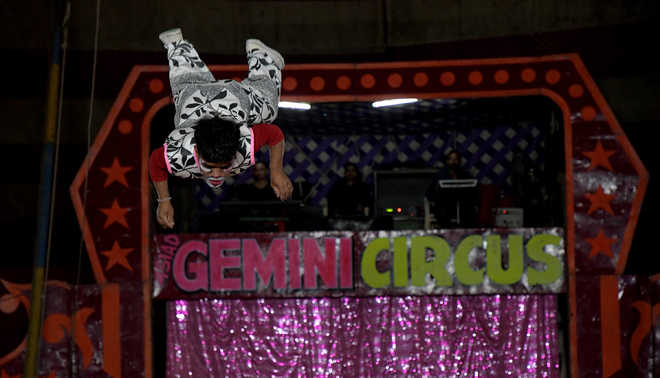
Over the years, the circus has lost its appeal and vitality due to the invasion of technology and restrictions on the use of animals. Photos: Ravi Kumar
Rahul Devesh
With a ticket worth Rs 150 in hand, I walked down a carpeted path to a huge tent of Gemini Circus in Mani Majra on Sunday. In the middle of it, a round stage was constructed with ropes hanging over it. In one corner, a big globe was installed for the stuntmen, slated to perform later with their motorbikes. On an elevation, an announcer and some musicians sat, constantly playing songs. The seating arrangement was divided into three parts according to the cost of the ticket.
It was not a packed house. Still a number of people had gathered with their children. Soon, a couple of clowns, short in stature, appeared on the stage. They were accompanied by a middle-aged man, who presented tricks with water bottles and hats. In the over two-hour-long show, gymnastics and acrobats constituted a major part. Stuntmen played with fire and drove bikes in the globe placed in a corner. Clowns had won applause. The unicyclist was also impressive.
However, despite the hard work put in by the artistes, it lacked the excitement. Magicians, jugglers and tightrope walkers were missing. It did not have artistes performing trapeze acts. Most importantly, animals were missing, which disappointed me. A circus without them seemed to be an act without soul.
But the organisers can’t be blamed. Over the years, first with the advent of cable television and now the social media, people have drifted away from it. The biggest setback has been a complete ban on the use of animals. Dwindling revenue forced experienced artistes to leave the profession with no one ready to teach the entrants. Then for how long can they survive like this? If Ajay Kumar, one of the circus managers who originally belongs to Barnala in Punjab is to be believed, it can survive only for five to 10 years. Banning the use of animals had been disastrous, he claimed. “The government could have issued guidelines, restricting the number of animals,” he added.
He still remembered the old days when the circus was a crowd-puller. “It even gave stardom to Bollywood star Shah Rukh Khan. Who can forget his programme, Circus,” he boasted. But even Ajay Kumar can’t do much after remaining associated with the profession for over four decades.
The situation of the artistes, with whom I met the next day, was more precarious. Mahendra Kapoor, a youth of 25, who is married, has been into the profession since childhood. Semi-literate, like many others, his parents too were circus artistes. He led me to the area where they stayed. Around 100 persons lived in separate tents. Bachelors were separated from married persons. Interestingly, all married persons were into the profession. Some had joined it to earn a living, while others like Charan Singh, who plays the role of a clown, consciously opted for it more than two decades ago.
A tiny tent, with a bed placed in the middle, was the dwelling place of the clown. A small fan was kept close to his bed. He was sweating. After the five-hour-long practice session, which started at 5 am every day, he was about to prepare for the show. A native of Kasganj in Uttar Pradesh, Charan Singh too did not expect much from the profession. “Earlier, we used to earn less but enjoy more. Now, we earn better but do not enjoy it. The response from people has not been encouraging,” he said when asked how he sees the changes that have taken place over the years. What to do next? His reply was, “We are farmers. I will go back home,” he said with a little smile on his face as if he had found another topic to make people laugh.
The next stoppage was at a nearby tent. It was occupied by a young couple— Sanjana and Pinchoo. Both belonged to Nepal. Their dwelling place was neatly maintained, with a television placed on a table, along with cosmetics. They had arranged a dish for it, which they had adjusted on their own. They have been performing gymnastics for the past 15 years. From where had they learned it? Simply, at home. “It was just a play,” they said. They joined the profession because they were attracted to it. It gave them satisfaction. For how long they can survive, they did not know.
As I took their leave, keeping their schedule in mind, an Ethopian artiste, Abinet, was practising on the stage. He, along with three others, was hired by the owner of the circus. He was paid higher. Interestingly, his country did not have the circus culture. He was trained at a centre in gymnastics, from where he was hired by the circus group.
Winding up my visit, as I said goodbye to Mahendra and Abinet, vivid memories flashed in my mind after seeing paintings of animals with a ring master instructing them. This was the circus I enjoyed more than 20 years ago as a child, where every elephant was Appu and every tiger Sher Khan. But now, technology and restrictions by the government are set to displace hundreds of people, making them a part of a larger workforce. Perhaps, with them go classics like “Mera Naam Joker”.
Ae bhai zara dekh ke chalo.



























